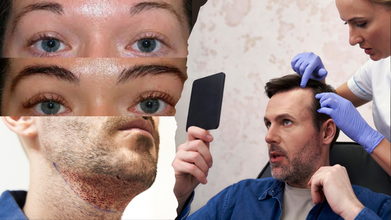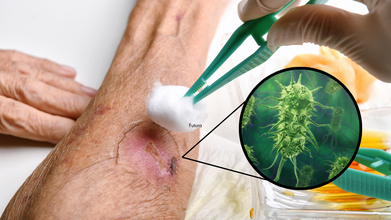- Health Conditions A-Z
- Health & Wellness
- Nutrition
- Fitness
- Health News
- Ayurveda
- Videos
- Medicine A-Z
- Parenting
- Web Stories
What Is Medetomidine? The Animal Sedative Now Turning Up In US Street Drugs

Credits: Canva
The Centers for Disease Control and Prevention (CDC) released three reports on Thursday that highlighted the clusters of medetomidine-related cases in Chicago, Philadelphia, and Pittsburgh. These reports have raised alarm about the growing presence of this drug in street opioids and the potential complications it brings to treatment and recovery.
What Is Medetomidine?
As per the American College of Medical Toxicology (ACMT), it is an alpha-2 agonist, similar to clonidine and xylazine, that is used clinically as a sedative and analgesic. It is categorized as an NPS due to its novelty in use. The CDC in its Morbidity and Mortality Weekly Report notes that it is a canine veterinary agent used for its anesthetic and analgesic properties.
However, the National Library of Medicine's study titled Classics in Chemical Neuroscience: Medetomidine has noted that this drug "has recently been detected in the illicit drug supply alongside fentanyl, xylazine, cocaine, and heroin, producing pronounced sedative effective that are not reversed by naloxone."
As per the latest CDC report released on May 1, twelve confirmed and 26 probable cases of medetomidine-involved overdose occurred in Chicago. Fentanyl was present in all blood specimens and drug samples that tested positive for medetomidine.
It was first identified in North America’s illicit opioid market in 2022, medetomidine is now showing up more frequently in mixtures with synthetic opioids—particularly fentanyl, the drug driving most overdose deaths in the U.S.
Why Is This Worrisome?
In May 2023, Chicago officials noticed a spike in overdose cases where naloxone—the standard overdose-reversal medication—did not work as expected. After investigation, the city's health department confirmed 12 cases involving medetomidine, with over 160 more suspected or probable cases, including one potential death. This marks the largest known medetomidine cluster to date.
The two other CDC reports focused on medetomidine withdrawal. In Philadelphia, testing revealed medetomidine in 72% of illegal opioid samples collected in late 2023, overtaking xylazine in frequency. Patients exposed to medetomidine experienced a distinctive type of drug withdrawal that didn’t respond to usual medications for fentanyl or xylazine. However, a related medication called dexmedetomidine showed some success in managing symptoms.
Pittsburgh reported 10 similar cases around the same time, suggesting the issue is not isolated to one area but may be spreading through regional drug supplies.
Why Does It Matter?
The presence of sedatives like medetomidine in illicit opioids creates several public health challenges:
Reduced effectiveness of naloxone: Standard treatment protocols for overdoses may not work when sedatives are involved, increasing the risk of death.
Complicated withdrawals: The addition of new, unregulated substances alters the withdrawal process, often making it harder to treat.
Lack of awareness and testing: Many emergency responders and clinics do not routinely test for medetomidine, which could delay proper care.
This development adds a new layer to the already complex U.S. opioid crisis. As drug suppliers continue to mix opioids with a variety of sedatives and adulterants, health officials face an evolving battle. Experts stress the importance of broader toxicology screening, continued research, and expanding the availability of alternative treatments like dexmedetomidine.
While medetomidine isn’t yet as widespread as fentanyl or xylazine, its growing presence in cities like Chicago, Philadelphia, and Pittsburgh points to a potentially dangerous trend—one that will require urgent attention from both medical professionals and policymakers.
COVID-19 Vaccine Update: You Are Eligible For The Vaccine If You Have These Conditions

(Credit-Canva)
Currently US is experiencing changes in their COVID vaccine guidelines. In the past few weeks, the Center of Disease Control and Prevention changed their vaccine eligibility guidelines for children, giving parents and their healthcare professionals the autonomy to choose whether they want to get their children vaccinated. This was a highly contested decision, so much so that the American Association of Pediatrics released their own guidelines stating that all children ages 6 to 23 months should get the vaccine.
This year's updated COVID-19 vaccines have been approved by the U.S. Food and Drug Administration (FDA) with a more specific focus. The approval is for adults aged 65 and older and for younger people who have certain medical conditions that put them at a higher risk for severe COVID-19.
Federal health officials say that anyone who wants a vaccine can still get one after talking with their doctor. However, this narrower approval might make it harder for some people to get a shot if they don't meet these specific criteria.
Who Is Eligible For The COVID-19 Vaccine?
According to the U.S. Department of Health and Human Services, the new vaccines from Moderna, Pfizer, and Novavax are available for people at higher risk. The Centers for Disease Control and Prevention (CDC) has a long list of conditions that can put someone at higher risk for a severe COVID-19 infection. These include common issues like
- Asthma
- Blood cancers
- Cerebrovascular diseases
- Chronic kidney disease
- Some chronic lung diseases
- Some chronic liver diseases
- Cystic fibrosis
- Type 1 and 2 diabetes
- Gestational diabetes
- Disabilities, including Down syndrome
- Heart conditions
- HIV
- Mood disorders, including depression and schizophrenia
- Dementia
- Parkinson’s disease
- Obesity
- Physical inactivity
- Current or recent pregnancy
- Primary immunodeficiencies
- Current or former smoking
- Solid organ or blood stem cell transplant recipients
- Tuberculosis
- Use of immunosuppressive drugs
What Are The Major Risk Factors For COVID-19?
According to the CDC COVID-19 while having an underlying health condition is a big risk factor for severe COVID-19, other things can also increase a person's risk. Age is the biggest risk factor. For example, people ages 50 to 64 have a risk of death that is 25 times higher than people ages 18 to 29. The risk keeps going up with age:
Ages 65-74: 60 times higher risk of death
Ages 75-84: 140 times higher risk of death
Ages 85+: 340 times higher risk of death
Race and Ethnicity also play a role. The pandemic has had a more severe impact on racial and ethnic minority groups. These groups are more likely to get COVID-19, be hospitalized, end up in the ICU, or die from the disease—often at a younger age. This is often due to problems with healthcare access, like not having health insurance or reliable transportation.
What Are Some Other Condition That Are At Risk of COVID?
For some health issues, the link to severe COVID-19 isn't as clear and needs more research. These include epilepsy, hemophilia, sickle cell disease, and substance use disorders. Other conditions, like high blood pressure and Hepatitis B or C, have shown mixed results in studies, so it's not yet certain if they increase a person's risk of severe illness.
The CDC also mentions that doctors should look at a patient's age, health problems, and vaccination status to determine their risk. Here's what they should do:
Suggest Vaccination
Encourage patients to get the updated COVID-19 vaccine, as it's safe and effective.
Prescribe Treatment
Give antiviral medicines early to eligible patients to significantly lower their risk of hospitalization and death.
Encourage Prevention
Advise high-risk patients to continue wearing masks and to keep up with their regular medical appointments to manage their health conditions.
Help Everyone
Be sensitive to the needs of different groups, including racial and ethnic minorities. Doctors should offer resources and support to help all patients get the care they need.
Not Just Bald Spots, Are Beard And Eyebrow Transplants The Next Millennial Beauty Obsession

Credits: Pinterest/iStock
Beards that look sharp on Instagram, eyebrows that frame the face just right, even fuller lashes, hair is no longer about the scalp anymore. Millennials are becoming more and more interested in beard and eyebrow transplants in order to achieve their desired look. The demand is no longer niche, say surgeons, thanks to grooming culture, social media, and new technology making these once-rare procedures mainstream. What this actually means is that hair transplants are moving away from being corrective bald spot fixings to being a cosmetic option, nearly like fillers or Botox.
For decades, hair transplants were linked almost solely to scalp baldness, furtively discussed and reserved for men fighting male pattern hair loss. Skip forward to 2025, and the discussion has widened exponentially. Now, beard, eyebrow, and even body hair transplants are not merely available but increasingly popular across gender and age boundaries. What was once a niche or even an extreme surgery has entered mainstream cosmetic and reconstructive medicine.
Cultural grooming and identity trends have redefined hair restoration demand. Thick eyebrows, which were plucked thin back in the 1990s and early 2000s, are now the standard of beauty. Social media and celebrity culture have further fueled the popularity of full brows, encouraging both men and women to undergo eyebrow transplants to obtain definition and fullness.
Beards also went from being an afterthought to a strategic style choice. A thick, even beard has long been considered a sign of masculinity and confidence, and frustrated men are increasingly seeking out surgical solutions. According to board-certified plastic surgeon Dr. Mayank Singh, "Hair restoration is no longer just restricted to the scalp these days. There has been a significant increase in demand for beard, eyebrow, and body hair transplants in recent years." Though most still equate transplants with hair loss, the surgery has developed into one of the most rapidly expanding trends in cosmetic medicine.
Who Is Selecting Beard And Eyebrow Transplant Procedures?
The demographic spread is wider than one might expect. Women with naturally thin brows, those who lost eyebrow hair due to alopecia, thyroid disorders, or chemotherapy, and even individuals with facial scars are seeking eyebrow restoration not just for beauty but for function—eyebrows help protect the eyes from sweat and debris.
Beard transplants, on the other hand, are most prevalent among males between their 20s and 40s. Some simply desire a fuller beard for looks, others are covering areas of thinning, and for many transmen, beard transplantation is a key aspect of gender identity confirmation. Such reasons are more than fashion, bordering on self-concept, confidence, and cultural significance.
What Is The Artistry Behind Transplants?
Unlike hair transplants on the scalp, face hair transplants require an added degree of accuracy. Transplanted hair angle, direction, and density need to be in sync with natural growth direction and the person's facial structure. Eyebrows are especially fussy. One millimeter of error can make all the difference in expression and balance.
That's the reason why decent clinics place equal stress on surgery and art. Since Dr. Singh explains, not all demands are possible, "Dramatic demands—such as for unnaturally thick body hair or transplants to unusual places—call for serious thought. Ethical professionals always consider safety, long-term results, and if the look will be natural."
More Than Vanity What Is The Medical and Practical Motivation For These Procedures?
Although most of these procedures are done for aesthetics, the medical indications are equally significant. Loss of eyebrow hair through burns, trauma, or autoimmune disorders can impact function as well as appearance. Beard transplants, likewise, can replace hair destroyed by scarring or trauma. Here, the procedure is more about making a person look and act normal again and gaining confidence rather than sheer fashion.
Are Body Hair Transplants The Outer Edge of the Trend?
One of the more unexpected trends is the request for body hair transplants. Chest, arm, and even lower body hair restoration have been requested. Although not common, they highlight how grooming standards differ across cultures and individuals. For surgeons, though, these types of unusual cases raise ethical concerns. Priority must be placed on ensuring procedures are safe, medically warranted, and provide realistic results.
Permanency and Aftercare
One of the most important questions patients have is if hair that is transplanted is permanent. The answer is yes—since donor hair comes from the scalp, a region that is genetically thinning-resistant, so no thinning will occur. The hair will grow normally once it is transplanted in its new position.
That being the case, aftercare is a little different. Eyebrow transplants, as an example, employ scalp hairs that grow longer and faster, needing to be trimmed regularly. Beard transplants require strict short-term aftercare to avoid infection and graft survival but, once healed, become a routine part of grooming. Body hair transplants vary depending on location but in most cases work by the same principle of permanence.
Role of Social Media and Pop Culture
The boom in such procedures cannot be divorced from the role of pop culture. Trends in grooming, especially those amplified on TikTok and Instagram, have made cosmetic treatments the new norm. Celebrities with thick brows or highly groomed beards provide aspirational benchmarks which filter into day-to-day style.
But it's not simply about keeping up appearances. For many patients, the choice is more about identity, self-expression, and confidence issues. Facial and body hair transplants occupy a different position than scalp hair transplants on the continuum between aesthetic enhancement and empowerment.
Balancing Demand With Responsibility
The rapid growth of these operations has positioned it as one of the most rapidly expanding segments of cosmetic medicine. Nonetheless, surgeons caution. Unrealistic expectations or requests that are based only on fleeting trends may result in disappointment. Ethical practitioners, as Dr. Singh insists, know when to turn down a case, "The goal is always to balance patient expectations with long-term safety and natural-looking results."
With advancing technology, facial and body hair transplants should become even more advanced, with reduced recovery periods and more natural results. Gone are the days when this was whispered about; now it's widely talked about, with clinics claiming record levels of patients consulting for beard, eyebrow, and off-the-scalp procedures.
Hair transplantation's evolution captures a larger trend in the way we think about cosmetic medicine. It's no longer merely a matter of curing baldness but achieving a style that matches one's personality, self-image, and confidence. From facial-framing eyebrows to beards representing virility and maturity, hair restoration is redefining what it means to assume command of one's appearance.
The emergence of beard, eyebrow, and body hair transplants is a reflection of how far hair restoration has advanced. Historically confined to baldness on the scalp, today it extends to aesthetics, identity, and function in equivalent proportion. Whether motivated by medical necessity, cultural factor, or simply personal fashion, these surgeries are yielding results that are permanent, natural, and frequently transformative.
Dr Mayank Singh is a board certified plastic surgeon , also a Fellow of ISHRS , exclusively into hair restoration for over 15 years and the Founder of CROWN, New Delhi.
Flesh Eating Bacteria Death Toll At 4 People, 22 Hospitalized, Does It Actually Eat Your Flesh?

(Credit-Canva)
Louisiana health officials have confirmed that two more people have died and at least 22 have been hospitalized from a flesh-eating bacteria called Vibrio vulnificus. This brings the total number of deaths in the state to four so far this year.
The bacteria is found naturally in warm saltwater and brackish water, as well as in raw or undercooked seafood. Two of the most recent deaths were from people who got sick after eating raw oysters.
What Is Flesh-Eating Bacteria/Vibrio vulnificus?
Vibrio are bacteria that live in coastal waters. While most types are harmless, some can cause severe, life-threatening infections, though this is rare. The Vibrio vulnificus strain is particularly dangerous and is responsible for more than 95% of all deaths from seafood-related illness in the United States.
Each year, nearly 80,000 people in the U.S. get sick from a Vibrio infection, mostly from eating contaminated food. Of those, about 500 are hospitalized, and around 100 die.
How Do People Get Infected With Flesh Eating Bacteria?
In Louisiana, officials have recorded 22 total cases this year, and all of those people had to be hospitalized. More than 80% of these cases happened when people were exposed to the bacteria through a wound on their skin while in saltwater. The remaining cases were from people who got sick after eating seafood, such as raw oysters. The bacteria are most common in warm coastal waters, usually between May and October. Because of this, state health officials have issued a warning for residents to take precautions to prevent infections.
Does Flesh Eating Bacteria Actually Eat Your Flesh?
According to the American Society For Microbiology, the term "flesh-eating" can be a bit misleading. From the bacteria's point of view, its goal is simply to survive. Humans are not its normal home—it's built to live in the ocean. When it gets into a human wound, it uses the tools it already has to stay alive in this new environment. Damaged tissue becomes a food source for the bacteria. By destroying cells, it can also protect itself from the body's immune system. Moving deeper into the body helps it find more food and avoid other germs.
Vibrio vulnificus has a set of tools, like special toxins and proteins, that break down body tissue and fight against the body's defenses. For example, one strong toxin called RtxA1 kills human cells and attacks the body's immune cells, allowing the bacteria to spread quickly.
The bacteria also really need iron to grow. This is why people with health issues that increase iron in their blood, such as liver disease, are at a higher risk of getting a deadly, full-body infection.
Interestingly, the damage isn't just caused by the bacteria. Sometimes, the body's own immune system can make things worse by releasing chemicals that increase swelling and destroy even more tissue.
How Can You Protect Yourself From Flesh Eating Bacteria?
The best way to stay safe is to avoid these infections in the first place. The CDC advises that if you have an open wound, like a cut or a new tattoo, you should stay out of salty or brackish water, including at the beach. If you do come into contact with water or raw seafood, immediately wash the wound with soap and water.
It's also very important to be aware of the risks, especially if you have other health issues. If you get a cut in saltwater and it starts to look infected—with swelling or pain—see a doctor right away. Tell them you were in seawater. The good news is that this bacteria is very sensitive to antibiotics, so catching the infection early is the key to getting better.
© 2024 Bennett, Coleman & Company Limited

